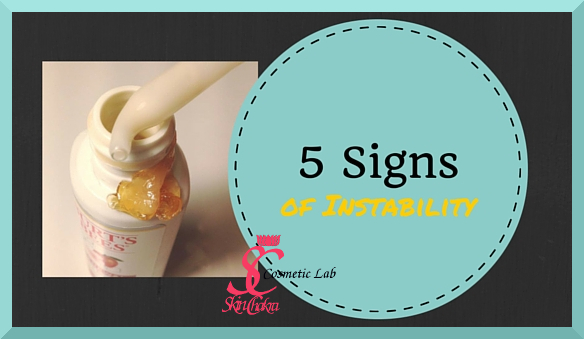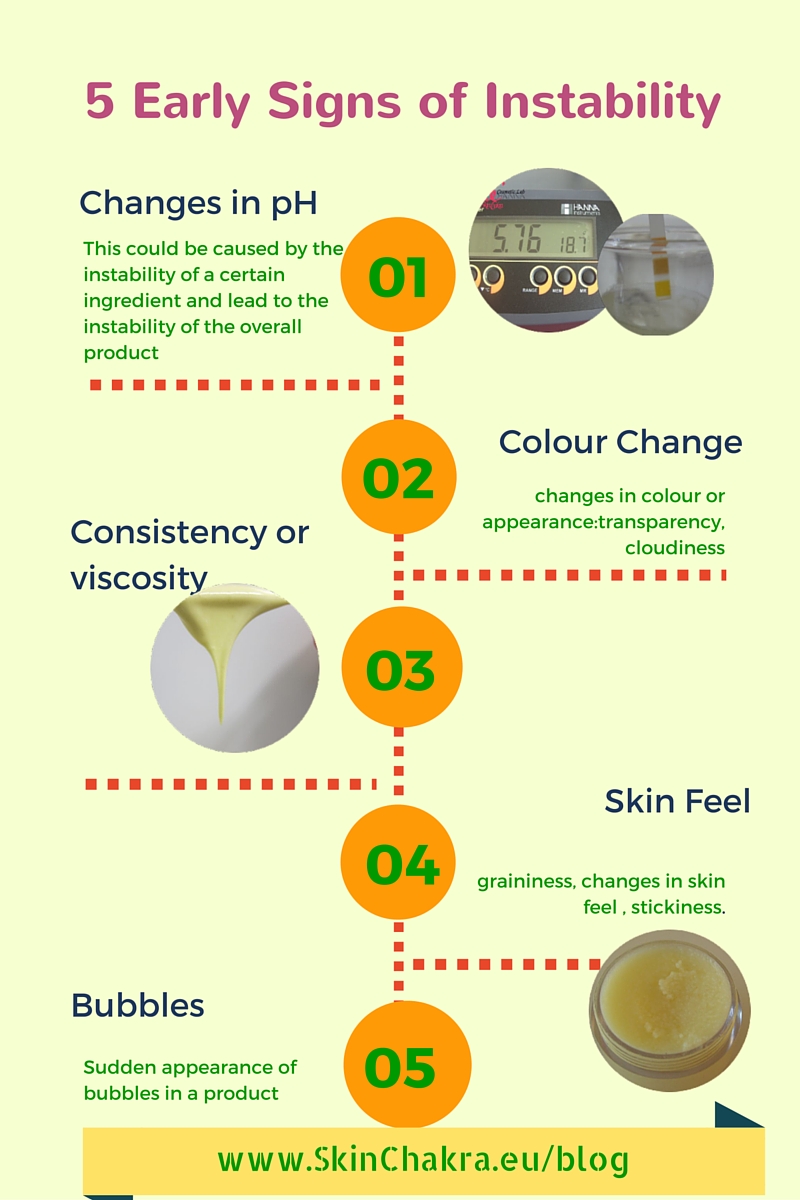
Dienstag, 29. März 2016
5 Early Signs of Instability of Your Cosmetic Products
Have you ever shipped a cream or a balm to another continent and have wondered whether your product arrives exactly as you've shipped it and whether it remains as it should till the very latest gram is consumed?
Well, this is something all of us feel as we daily ship samples and products from one part of the world to the other part.
In today's global business you may send a product from Canada's cold winter to Australia's hot summer and hope that the product and the packaging would survive all the changes in temperature, humidity and pressure during the transport.
But hoping is not enough. In order to run a successful business and to avoid complaints and refunds you have to be aware of the behaviour of your product and packaging under different conditions.
This is why stability testing is one of the most important and time consuming (yet most neglected) steps in a product design and development.
Being an artisan manufacturer of cosmetics and producing in small scale or even "bespoke" and "on demand" does not remove the responsibility from your shoulders. Quite on the contrary it increases your responsibility and your moral obligation towards your customers.
A customer may easily discard a drugstore emulsion purchased for less than 5.00 € if it is not desirable or phase separated but very probably would not do the same with your precious and much more expensive "natural & organic" product for which she has paid a much higher sum.
Not having the right instruments and state-of-the-art equipment is no excuse for instability of a product. There are indeed some tests which should be outsourced to a specialized laboratory with enough experience and suitable equipment. These include:
- Challenge testing
- Photostability testing of colour cosmetics
- Stability of SPF for suncare products
- Texture and hardness analysis of a lipstick or deodorant stick
But there are other simple (yet effective) tests which you should easily run for your products (your prototypes during the development phase of the product or the real batch production) in your small cosmetic lab.
Let me show you some early signe of instability of cosmetic product which are easily detectable with a very low investment and with what you already have in your laboratory:
1- Colour change
Well, working with "organic and natural" ingredients, you certainly know that these are more sensitive to light compared to synthetic colourants. There is even some degree of acceptance in colour change and not every colour change should be alarming to you.
In the above photo, you can observe a freshly prepares spirulina soap vs. an aged one. Spirulina is not only a superfood and an amazing skin care ingredient, it is an outstanding colourant for soap. However, as you can judge yourself, it is unfortunately very unstable to the light. This doesn't mean however any deterioration or damage of the soap. You have to either accept this (and inform your customer about it) or store the soap protected from light during the ageing and then wrap it immediately so that the brilliant colour doesn't fade away. In any case you shall inform your customer that the colour of the soap will fade away upon exposure to light.
There is however another kind of colour change that is alarming and is caused by instability. This could be decay of vitamin C which causes a yellowish colour or inactivation of your preservative system. These changes lead to the overall instability of the product (in case of preservative inactivation it even causes to contamination which is certainly something you want to avoid).
2- Changes in pH
As you certainly know, this symptom is only significant for water containing products. If the pH of your tonic or your emulsion or your cleansing foam changes with time (during its shelf-life), there is something going wrong in the product and you should investigate it seriously. Changes in pH are cause by instability of some ingredients in the product and could on its own cause further instability of other ingredients.
I just have a very vivid example the last week: A student has aske why the brilliant pink colour of her hibiscus tonic has faded away t a dull pink shade in less than two weeks. As I asked her to check the pH the answer was as I expected: the pH has been changed.
Many plant colourants such as anthocyanins (hibiscus or elderberry for example) are sensitive to pH and their colour varies depending on the pH. It means in simple words, that by monitoring the pH of your products, you have a simple way of monitoring the stability of your product.
3- Changes in Viscosity and consistency
For an exact measurement of viscosity you need instruments that are not on your top-priority list as you equip your cosmetic lab. But there are simple ways to monitor the viscosity of an emulsion or cream and to compare the viscosity of multiple products. You can even detect the changes in consistency of a product if you practice enough and if the changes are noticeable.
Changes in viscosity and consistency are important alarms for the instability of a product.
4- Changes in skin feel
Well, for this one you just need your very own skin and no instrument.
Any changes in skin feel of a product: stickiness, graininess, unpleasant after feel or similar symptoms are early signs of instability of a cream, balm or an emulsion and should be furthe rinvestigated.
5- Bubbles and water droplets
Bubbles are very desirable when you make a bubble bath but they are alarming when they suddenly appear in an emulsion, a gel or any other product. It means that some ingredient is being decayed and the decay product is a gas (most often oxygen or CO2). This happens very often during microbiological contamination of a product and should be investigated very seriously.
Sweating is another symptom of instability. This happens when you close a balm or butter as it is still very hot (and can cause a contamination with time) or when a solvent (usually water or alcohol) is being evaporated out of the product. In any case, sweathing should be considered as an instability alarm.
Are you interested and want to know more about stability testing? Join me for the "Certificate in Cosmetic Stability Testing" to find the answer to your questions and to know how to design a custom stability testing for each individual product.
Thanks for your visit.
Feel free to send me your comments and questions. I really enjoy your participation in our Facebook discussions.
Be Happy and have fun



